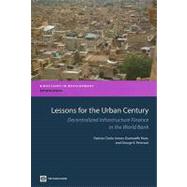
Note: Supplemental materials are not guaranteed with Rental or Used book purchases.
Purchase Benefits
What is included with this book?
| Foreword | p. ix |
| Acknowledgments | p. xi |
| About the Authors | p. xiii |
| Abbreviations and Acronyms | p. xv |
| Executive Summary | p. xix |
| Introduction and Objective | p. 1 |
| The Role of Demographics | p. 2 |
| The Role of Decentralization | p. 5 |
| The Role of Financial Liberalization | p. 6 |
| Objective of this Review of Experience | p. 7 |
| Trends and Structure of Urban Infrastructure Funds (UIFs) | p. 9 |
| Composition of UIFs by Sector Board over Time | p. 10 |
| Long-Term Trends in the Volume of UIF Lending | p. 11 |
| Performance of UIFs | p. 17 |
| UIF Design: Options for Intermediation Strategy | p. 21 |
| Learning from Experience in Project Design | p. 31 |
| Transplanting the Line of Credit Model in Sub-Saharan Africa | p. 31 |
| South Asia: Adapting the Credit Model | p. 36 |
| Rethinking Support for Local Infrastructure Investment: Municipal Grants and Social Funds | p. 37 |
| Supporting Municipal Infrastructure Investment in Centralized Systems | p. 43 |
| Commercial Banks and the Development of Sustainable Municipal Credit Systems | p. 46 |
| Agenda for Future Work | p. 51 |
| Conclusions | p. 63 |
| Methodology for Selecting and Identifying Urban Infrastructure Funds Financed by the World Bank | p. 69 |
| List of UIFs Reviewed | p. 75 |
| List of Currencies Available for Swaps from IBRD Loans as of January 3, 2008 | p. 83 |
| References | p. 85 |
| Index | p. 89 |
| Boxes | |
| A Model of Market-Oriented Reform: Credit Local de France | p. 24 |
| Monitoring Municipal Financial Market Development: The Czech Republic | p. 58 |
| Figures | |
| Urban versus Rural Population Growth Worldwide through 2030 | p. 3 |
| World Urban Population Growth through 2030: Low- and Middle-Income versus High-Income Countries | p. 3 |
| Distribution of World Urban Population Growth through 2015 by City Size | p. 4 |
| Selected Mega Cities' Growth Rates through 2010 | p. 5 |
| UIF Commitments by Region and Sector Board | p. 10 |
| UIF Commitments by Country | p. 10 |
| Annual UIF Commitments by Sector Board | p. 11 |
| Trends in Total Urban Infrastructure Fund Lending-Annual Averages | p. 11 |
| Trends in Annual Average Urban Infrastructure Fund Lending by Infrastructure and Non-infrastructure Sector Boards | p. 12 |
| Trends in Annual Average Project Size | p. 13 |
| UIF Lending Projects | p. 14 |
| UIF Grant Projects | p. 14 |
| Outcome Ratings for UIFs | p. 18 |
| Selected Outcome Ratings for UIFs by Sector Board | p. 18 |
| Disbursements as a Percentage of Commitments for UIFs | p. 19 |
| Loan Recoveries in UIFs: Reporting and Repayment Rates by Institutional Arrangement | p. 20 |
| Loan Financing versus Grant Financing of Subprojects by Sector Board | p. 27 |
| Development Objective: Development of Municipal Credit Market by Sector Board | p. 28 |
| Development Objective: Development of Municipal Credit Market over Time | p. 28 |
| World Bank Project Approvals: FY1971-FY2006 | p. 70 |
| Tables | |
| UIFs by Region | p. 7 |
| Financial Intermediation versus Poverty-Oriented Grants | p. 27 |
| Municipal On-Lending Projects in Sub-Saharan Africa | p. 33 |
| Municipal Grants and Infrastructure Programs | p. 40 |
| UIF Projects by Region | p. 72 |
| Table of Contents provided by Ingram. All Rights Reserved. |
The New copy of this book will include any supplemental materials advertised. Please check the title of the book to determine if it should include any access cards, study guides, lab manuals, CDs, etc.
The Used, Rental and eBook copies of this book are not guaranteed to include any supplemental materials. Typically, only the book itself is included. This is true even if the title states it includes any access cards, study guides, lab manuals, CDs, etc.